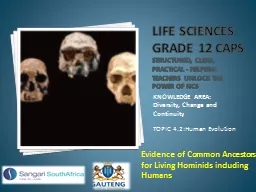PPT-The Last Ape Standing
Author : giovanna-bartolotta | Published Date : 2017-08-16
It is therefore probable that Africa was formerly inhabited by extinct apes closely allied to the gorilla and chimpanzee and as these two species are now mans nearest
Presentation Embed Code
Download Presentation
Download Presentation The PPT/PDF document "The Last Ape Standing" is the property of its rightful owner. Permission is granted to download and print the materials on this website for personal, non-commercial use only, and to display it on your personal computer provided you do not modify the materials and that you retain all copyright notices contained in the materials. By downloading content from our website, you accept the terms of this agreement.
The Last Ape Standing: Transcript
Download Rules Of Document
"The Last Ape Standing"The content belongs to its owner. You may download and print it for personal use, without modification, and keep all copyright notices. By downloading, you agree to these terms.
Related Documents














